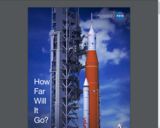
This video demonstrates how satellites are used to track ice cover and global warming.
- Subject:
- Earth Science
- Science
- Material Type:
- Lesson
- Provider:
- NASA
- Author:
- NASA
- Date Added:
- 02/26/2019

This video demonstrates how satellites are used to track ice cover and global warming.

Part 1 of the X-ray Spectroscopy Unit from NASAs Imagine the Universe! lesson plans includes a series of three lessons on the formation of elements in stars. During this three lesson series, students learn about the life cycle of stars and model the formation of elements in stars. The lessons are a demonstration of type so fusion reactions and modeling not just the changes to matter during the processes but also the energy involved in these reactions.

This interactive shows the change in ice levels on the planet.

This demonstration uses a water balloon to show how Earth's oceans are absorbing most of the heat trapped on our warming world.

This video graphic shows the change in global warming for the past century.

In this STEM lesson, students follow the engineering design process to design and build a crane out of cardboard. They will determine methods to reinforce the crane's arms so it doesn't collapse under a heavy load. This activity is based on Robotics applications.

Students will construct a CD hovercraft and apply Newton's Laws of Motion to make them work. They will also investigate how hovercraft reduce friction, learn how the technology is used in training astronauts for space missions, and design their own hovercraft competitions.

NASA resource about forces and non-standard units of measurement. This resource has background reading that is fairly high level and great diagram, but no student-facing materials.

This infographic highlights all of the factors that contribute to carbon dioxide increase on the planet.

This infographic highlights information about sea level rise, as it relates to global warming.

This lesson plan includes discussion questions and activities to help students understand the importance of physical activity in establishing and maintaining lifelong health-enhancing behaviors, as well as, help them understand conditioning to enhance movement performance.

Students are introduced to actions that either hurt or help Earth as they advance their game pieces around the board.

In this series of activities, students will design and build models of nine life support systems which are crucial to a successful settlement of the Moon. They will make plans based on their knowledge of how these systems work on Earth.

Students create a working model of a lunar biosphere that is a balanced, self-enclosed living system able to run efficiently over a long period of time.

Teams of students will present proposals for developments on the Moon in a competition for approval from a student-staffed Lunar Council.

In this STEM unit, students participate in an activity to grow plants in an environment very similar to the moon, which is designed in a unique partnership between NASA scientists and engineers and education professionals. The lesson incorporates leading-edge insight and practical experiences for students on how NASA works with plants. Students will describe the need for life science research on the International Space Station and the moon. They will also identify various plant species that are suitable for lunar plant growth and their requirements. In the culminating activities, students design and construct a working prototype of a plant growth chamber.
.

Students construct a model of a lunar roving vehicle.

Students use large-format images of Mars to reach conclusions about the geology of Mars. Students are tasked with identifying features on the surface of Mars, determining the surface history of the area, calculating the size of features, and developing research questions.

This board-game activity teaches students the process of design, engineering and technology for a mission to Mars.